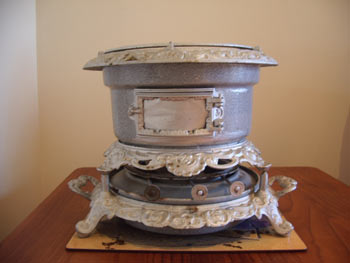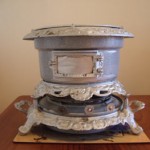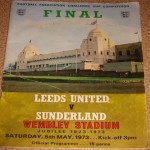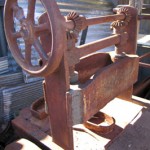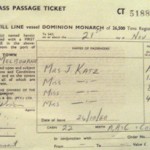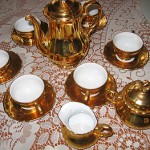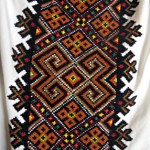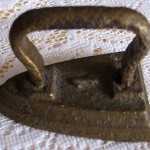(nee Criminale)
Maltese
Marsa, Malta
Anglu, Malta
on 21 April 1951
Sydney on 5 June 1951
Fisherman’s shack at Yarra Bay, Matraville, Sydney
Father’s first job was at the Brewery at Moore Park, Sydney
My father’s next job was at British Standard Machinery in Mascot, Sydney
There was very little left for people in Malta after the World War 2. Work and money were scarce and the island was physically devastated by bombing during the war. Australia was seen as a country of opportunities. So in 1950 my father bought a ‘ten pound passage’ and travelled to Australia by ship to get a job and find a place for us to live. When he arrived he found a boarding house in Surry Hills.
On 21 April 1951 my mother, my four sisters and I boarded the MS Florintina in the port of Anglu, Malta and started our journey to Australia. Apart from our clothing my mother brought a small kerosene spiritera, a big soup pot and a big bath with her on the journey. These were all just household items things from our home in Malta. She was not sure what to expect in Australia and thought she might need these things and they did prove to be very useful later on!
For us children the trip was a big adventure. I was only three years old at the time but I can remember stopping in Sudan and seeing people carrying bananas on the dock. Mum kept telling us to stay away from them because they were sure to have lice. I can also remember her telling us to stay away from the ships porthole – we must have been a handful for her – five young girls all under eight years old on a three month sea journey. I can also remember that the food was pretty horrible – basically bread and water.
We arrived in Sydney at night and I can still hear the sound of people greeting each other – it was very noisy and confusing and then all of a sudden Dad was there to take us to our new home. He had found a little shack at Yarra Bay for us to live in – on Hill No 60 – that was the address. There were a lot of Anglo-Australians and Aboriginal people living there then. These places had been built in the 1930s depression. For many years I thought we had squatted there but then Dad said they had bought the place.
After a while we moved around the corner to a converted boatshed – a two room shack which we rented.
As children we loved living there – it was such fun to be able to swim, fish and picnic as we liked. But it must have been hard for mum. There was no electricity and only one water tap to service everyone living in that community at Yarra Bay. Mum had to walk quite a way to get water and the she had to carry it back to the shack and had to heat it on the kerosene spiritera – for all our baths, clothes washing and cooking.
Dad by this stage had his job as a fitter at British Standard Machinery in Mascot – the job he had for the rest of his working life. We didn’t have a car so he caught public transport and I can remember seeing him arrive home – walking over the hill in the dark and then digging holes to bury our household waste. He used to say he was running out of space for holes!
In about 1953 I started school at the Catholic school in Yarra Bay where my sisters went. I can remember one day one of the nuns hit my sister who immediately went home to tell mum. Mum marched up to the school and got the five of us and marched us across the road to the public school – we looked like a mother duck and five little ducklings – my mum was a strong person. She didn’t speak English and must have been lonely but she still did her time working at the public school canteen.
We lived at Yarra Bay for about four years and during that time my little brother was born. In about 1961, towards the end of our time at Yarra Bay, we sponsored my aunt and uncle’s family to migrate to Australia from Malta and they moved in with us. Dad built another room onto the shack but it wasn’t Council approved so they ordered him to take it down – so we slept five in a bed. In the end we were sent to government organised accommodation – a former army barracks in Warwick Farm in western Sydney where we paid rent. Dad travelled to Mascot each day for work – a huge distance so mum applied for a Housing Commission house and eventually we got one at Maroubra. It had four bedrooms and indoor plumbing – very exciting! It was here that mum had my youngest sister and I went to high school.
When the kids were all at school, Mum found work cleaning at Little Bay Hospital at Randwick and later she found work at Qantas. In 1971 after many years of hard work Mum and Dad bought a place at Monterey. While they were moving Mum found the spiritera that she had used at Yarra Bay. She wanted to throw it out but I could remember her using it in our first house in Australia and couldn’t bring myself to let her so she gave it to me. It had travelled from Malta and they kept it right up until then.
I left school at 16 and found work as a dressmaker for a business located in the old Tivoli building in the city. We used to sew for the games show personality Dolly Dyer and Miss Australia winners- beautiful work for a high society clientele.
I met Laurie Peadon when I was 18 and we got married in 1968. Mum and Dad didn’t worry that he was an Australian and not from the Maltese community – you see they kept in contact with the Maltese community but they also wanted to have ‘Aussie’ friends. When I was growing up there was a bit of a stigma about being a New Australian so we tried hard to fit in and felt at home.


